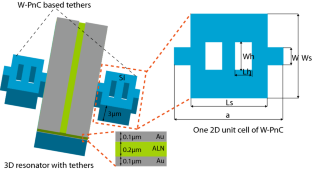利用窗状声子晶体条改善压电激励MEMS谐振器的锚定品质因子
摘要
拥有卓越的质量因子(Q)有助于促进微机电系统(MEMS)谐振器的优势,因为它对物联网和射频应用中基于MEMS技术的振荡器和滤波器的性能产生影响。锚定品质因子(\(Q_{\textrm{anchor}}\))是测量MEMS谐振器到衬底的锚定能量损失的主要参数之一,是确定q的主要参数之一。在本文中,提出了一种窗口状声子晶体(PnC)条,即W-PnC,作为弹性波传播的屏障,在硅基氮化铝(ALN)谐振器的支撑系索中。因此,谐振器\(Q_{\textrm{anchor}}\)被高度提升。该W-PnC产生24.11 MHz宽度的带隙(BG)。它覆盖了谐振器的152.5 MHz谐振频率。在\(Q_{\textrm{anchor}}\)改进的对比中,无孔声子晶体(WH-PnC)、带圆短段声子晶体(C-PnC)和四分之一波长声子晶体(L-tether)三种传统支撑结构与W-PnC相对应。通过改变W-PnC的尺寸参数,评估了其带结构中BG形成的变化,为设计人员选择最佳BG提供了平台。数值结果表明,W-PnC谐振腔的\(Q_{\textrm{anchor}}\)性能优于同类谐振腔。具体来说,采用双单元W-PnC所研究的谐振腔的\(Q_{\textrm{anchor}}\)增加了510.90%, 1771.70%, and 1048.51% over the WH-PnC, C-PnC, and L-tether, respectively. The W-PnC demonstrates its high effectiveness over other counterparts in reducing/eliminating the anchor dissipation energy source of the resonator. In addition, the BG properties of the W-PnC, such as gap width and gap location, depend on its dimensional parameters. The finite element analysis based numerical simulation method in this work is performed in COMSOL Multiphysics. The MATLAB scripts then solve the posting process of these simulations.

Owning a superior quality factor (Q) helps contribute to the advantages of microelectromechanical systems (MEMS) resonators due to its impact on the performance of MEMS technology-based oscillators and filters in IoTs and radio frequency applications. Anchor quality factor (\(Q_{\textrm{anchor}}\)), which measures the anchor energy loss from the MEMS resonators into their substrate, is one of the main parameters in determining Q. In this paper, a window-like phononic crystal (PnC) strip, namely W-PnC, is proposed to act as a barrier of elastic wave propagation in the support tethers of an Aluminium Nitride (ALN)-on-Silicon (Si) resonator. As a result, the resonator \(Q_{\textrm{anchor}}\) is boosted highly. This W-PnC generates a bandgap (BG) with a width of 24.11 MHz. which covers the 152.5 MHz resonant frequency of the resonator. Three traditional support structures, including phononic crystal without hole (WH-PnC), phononic crystal with circle stub (C-PnC), and quarter wavelength (L-tether), are the counterparts of the W-PnC in the comparison of the \(Q_{\textrm{anchor}}\) improvement. By changing the dimensional parameters of the W-PnC, the variation of the BG formation in its band structures is evaluated to provide a platform for the designers in choosing the optimal BGs. The numerical results show that \(Q_{\textrm{anchor}}\) of the resonator with the W-PnC is superior to its counterparts. Specifically, the \(Q_{\textrm{anchor}}\) of the resonator investigated with the two unit cell W-PnC increases 510.90%, 1771.70%, and 1048.51% over the WH-PnC, C-PnC, and L-tether, respectively. The W-PnC demonstrates its high effectiveness over other counterparts in reducing/eliminating the anchor dissipation energy source of the resonator. In addition, the BG properties of the W-PnC, such as gap width and gap location, depend on its dimensional parameters. The finite element analysis based numerical simulation method in this work is performed in COMSOL Multiphysics. The MATLAB scripts then solve the posting process of these simulations.

 求助内容:
求助内容: 应助结果提醒方式:
应助结果提醒方式:


